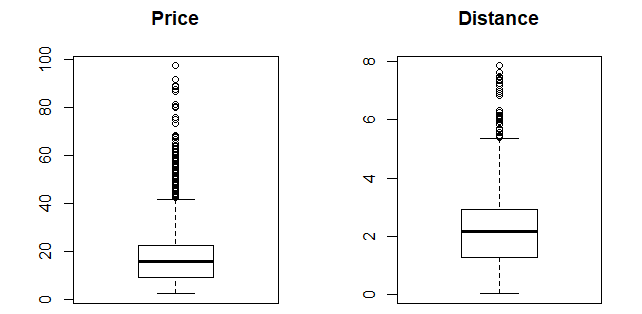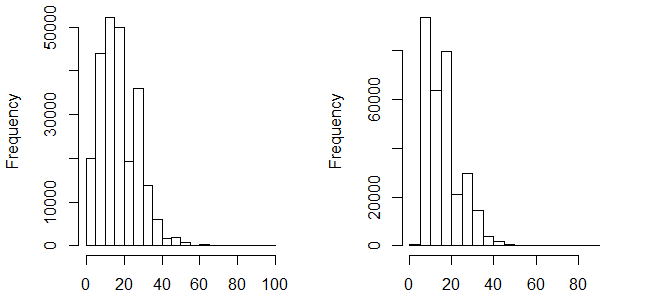Load_clean
Part 1. Cleaning the database
R code block:
library(readr)
NY <- read_delim("C:/Users/DDD/Desktop/NY.csv", ";", escape_double = FALSE,
trim_ws = TRUE)
NY = ny
library(dplyr)
attach(NY)
cleaning data
Due to the existence of N/A in price (our dependent variable, we fill them with the mean of the variable).
rider$price_1 <- ifelse(is.na(rider$price), mean(rider$price, na.rm=T), rider$price)
rider$longitude <- ifelse(is.na(rider$longitude), mean(rider$longitude,
na.rm=T), rider$longitude)
rider$latitude <- ifelse(is.na(rider$latitude), mean(rider$latitude,
na.rm=T), rider$latitude)
Making dummy variables for source and destination variables
ri <- fastDummies::dummy_cols(rider, select_columns = c('source',"destination"))
ri <- select(ri, -c('price'))
ri$id <- 1
NY %>% count(surge_multiplier, sort=T)
# For the database of Uber, we found that they do not consider the 'surge_multiplier'
# variable to define its price, while for Lyft, indeed they consider the 'surge_multiplier'
# but only for the distance, it is, the 'surge_multiplier' is related to the distance of the trip.
NY %>% select(starts_with('source_')) -> so
NY %>% select(starts_with('destination_')) -> de
dateOnly <- as.Date(rider$datetime, "%d/%m/%Y")
dae <- weekdays(dateOnly)
da <- as.data.frame(dae)
data.frame(c(so, de)) -> x1
data.frame(c(x, x1, da)) -> ny
write.csv(ny,'ny.csv')
After we cleaned the data, we decided to save the final datafile as csv and reload it again, now the database occupaies less space, and it is the definitive version.
Create Training and Test data -
NY %>% select(-c('id', 'month', 'day','hora')) ->NY
NY %>% filter(cab_type == 'Lyft') -> lyft
NY %>% filter(cab_type == 'Uber') -> uber
uber <-within(uber, rm('cab_type'))
lyft <-within(lyft, rm('cab_type'))
We proceed to remove the outliers of the database for a better estimation
library(data.table)
outlierReplace = function(dataframe, cols, rows, newValue = NA) {
if (any(rows)) {
set(dataframe, rows, cols, newValue)
}
}
NY= outlierReplace(NY, "price", which(NY$price >40), NA)
NY = na.omit(NY)
NY = NY
lyft= outlierReplace(lyft, "price", which(lyft$price >40), NA)
lyft = na.omit(lyft)
uber= outlierReplace(uber, "price", which(uber$price >40), NA)
uber = na.omit(uber)
set.seed(45)
training_u <- sample(1:nrow(uber), 0.7*nrow(uber))
trainub <- uber[training_u, ]
testub <- uber[-training_u, ]
set.seed(45)
training_ly <- sample(1:nrow(lyft), 0.7*nrow(lyft))
trainly <- lyft[training_ly, ]
testly <- lyft[-training_ly, ]
lyft %>% count(surge_multiplier, sort=T)
Mean Tables
table(month,cab_type)
mean(lyft$price)
mean(uber$price)
numeric <- NY %>% select_if(is.numeric)
numeric %>% as.matrix() %>% cor() %>% .[,"price"] %>% sort(decreasing = T) -> corr
corr %>% as.table() -> corr
corr
par(mfrow=c(1, 2))
boxplot(NY$price, main="Price", sub=paste("Outlier rows: ",
boxplot.stats(NY$price)$out)) # box plot for 'speed'
boxplot(NY$distance, main="Distance", sub=paste("Outlier rows: ",
boxplot.stats(NY$distance)$out)) # box plot for 'distance'
Here’s the Boxplot:

Some graphs
library(dplyr)
library(ggplot2)
hprice <- ggplot(NY, aes(x=price)) +
ggtitle("Price histogram") +
theme_fivethirtyeight() +
geom_histogram(color="black", fill="coral4")
hdist <- ggplot(NY, aes(x=distance)) +
ggtitle("Distance histogram") +
theme_fivethirtyeight() +
geom_histogram(color="black", fill="coral")
hprice
hdist
boxplot(price ~ cab_type, data = NY, col = "red")
Here’s the price histogram:

Correlation tables
library(corrplot)
nNY <- NY %>% select(price:visibility)
nNY <- nNY %>% select_if(is.numeric)
cor <- round(cor(nNY),2)
corrplot(cor, method="number", type="upper", tl.cex = 0.6)
Finally some graphs in ggplot
ggplot(NY, aes(x=longitude, y=latitude)) +
+ geom_hex(bins=12, show.legend = T)+ ggtitle('Sources and Destinations')
ggplot(NY, aes(x=longitude, y=latitude)) +
geom_hex(hbin=12)+ ggtitle('Sources and Destinations')+
ggtitle('Sources and Destinations')
NY %>% group_by(day) %>% summarize(n=n()) %>%
ggplot(aes(x=day,y=n)) + geom_point() +
geom_line(aes(group=1), linetype='dotted')+
ylab('Trips')+xlab('Day')+
ggtitle('Trips by day')
tema = theme(
axis.title.x = element_text(size = 8),
axis.text.x = element_text(size = 8),
axis.title.y = element_text(size = 10))
ggplot(data = rider, mapping = aes(x = source, y = price)) +
geom_boxplot() + tema + ggtitle('Prices by sources')
This is the end or part 1.